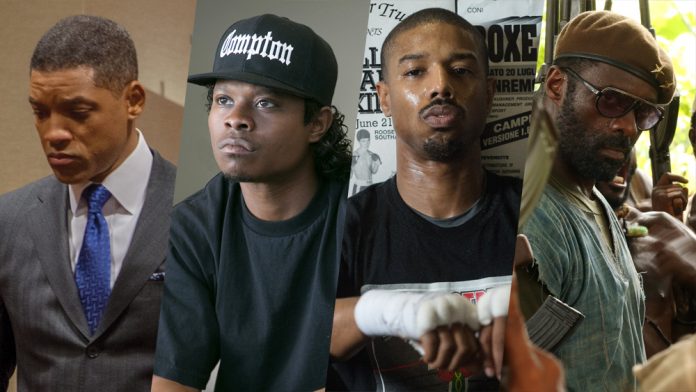In no other place can racism project itself across so many people’s minds. Movies captivate young and old, man and woman, black and white. Viewed by millions upon millions and telling a wide variety of stories, movies have passed on the ideologies of their makers or the stereotypes of peoples, inadvertently or not, throughout history. In this way, movies have truly been “signs of the times,” reflecting opinions of people in that time period have towards different races.
When one thinks of racism, the idea of white vs. black typically comes to mind first. Rooted in slavery, prejudice against African Americans persisted into the beginning of the 20th century as it was only a few decades after the Emancipation Proclamation. Movies reflected that societal theme, notable and blatantly racist examples including The Birth of a Nation (1915). Labeling blacks as sexually aggressive and the Ku Klux Klan as heroic, it was very well received by white audiences, who “[paid] an unprecedented $2 a ticket to see it,” according to PBS. Conversely, it provoked riots among African Americans at theaters and caused the NAACP to push for a ban. Furthermore, Chicago legislators passed laws that banned similarly racist films.
Indicating how much America has grown since 1915, a new movie by the same name was released just this year. This version of The Birth of a Nation shares nothing in common with the older film but saves the title. It chronicles Nat Turner’s 1831 slave revolt during which, Nat Turner and the slaves of the film portrayed as heroes. It is not, however, movies themselves like The Birth of a Nation (2016) that change racial attitudes, according to Mr. Fred Donahue. “I think the racial message of movies such as these serve more to reinforce the existing attitudes and beliefs of their viewers than [to] change any strongly held positions,” he said. Given the time period, it’s sound logic to assume that the white majority of America flocked to theaters to watch the overtly racist movie. Since laws and therefore general attitudes have changed, movies have evolved as well.
Yet, while many people tend to focus on prejudice against blacks, they are not the only minority that has been victimized throughout the years. Asians, Hispanics, and Middle Easterners all have been stereotyped in movies (not to mention many, many other races).
Take, for example, Breakfast at Tiffany’s (1961). Mickey Rooney, in yellowface, plays a buck-toothed and accented Asian stereotype named Mr. Yunioshi. Though these attributes were given to the character to produce some comedy, yet even the creators of the movie have “acknowledged [that] Yunioshi [is]…a toxic caricature” (The Wall Street Journal). Nevertheless, not all Asian characters are like Mr. Yunioshi. Perhaps the most hope comes from television shows right now. The ABC show Fresh Off the Boat centers around an Asian family in a typical American suburb and is funny without using many stereotypes.
As for Mexican stereotypes in Hollywood, in our present time, borderline racist roles are still cast. Mexican Ambassador Eduardo Medina Mora said, “Even our best actors, like Demián Bichir, cannot escape the gardeners and drug dealers trap for Mexicans in Hollywood,” declaring that it “implies that they are not capable of doing anything else” (Forbes). These sorts of generalizations are rooted in some fact – Hispanic workers do garden and are members of cartels; nevertheless, they also work in office buildings, restaurants, and stores just like anyone else. Furthermore, they do create a backlash as evidenced by the Mexican Ambassador’s words on the issue.
Finally, Middle Eastern characters are generally cast for a certain type of role as well, the terrorist. Mr. Donahue said, “Popular movies always need heroes and villains, and those chosen for such roles often mirror existing fears of society. Terrorists in the 1950s and 60s were Russians or Asians; today they are Middle Eastern.” Because of the modern issues of war in the Middle East and Islamist terrorism, there is a great “appetite” for movies that tell those sorts of stories says the Los Angeles Times. However, the article says that “the roles suddenly being created for Arab-heritage actors often are limited to those of terrorists or are…poorly drawn.” With few roles created for actors of Arab descent that are not related to national security, many are not able to make their way in the film industry.
How will these problems be solved? “Minority roles will improve when more minorities are working in the higher positions in the movie industry,” said Mr. Donahue. Indeed, whites are cast in an unexpectedly large amount of roles relative to other races. A study conducted by the University of Southern California found that out of the top 100 films of 2014, 73.1% of roles were white, 12.5% were black, 5.3% were Asian, 4.9% were Hispanic, and 4.2% were other (PBS). This disparity in roles manifested itself at this year’s Academy Awards, which had no black nominees and sparked massive controversy, with some actors boycotting the event. Movies have come a long way since their beginning at the turn of the 20th century, but they are not perfect quite yet.






